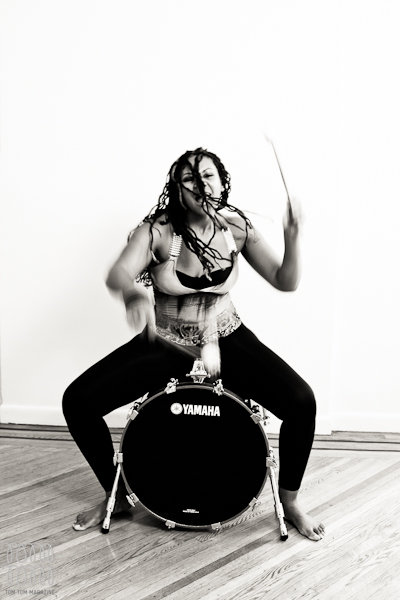Having a residency is a wonderful thing for those of us seeking security in the music business. I am very thankful to perform every week at Tutuma Social Club located in New York City, however at times it can be a challenge. A resident gig presents both positives and negatives. When I first got the gig I was so new to the genre that I was more than gracious to have the opportunity to learn. I quickly realized I had to get out of my normal routine and comfort zone and instead experience playing with others as much as possible. You never want to become stagnant in your playing. There is always and should always be opportunity to grow and you can not do that by playing one gig or one style all the time.

It is important to know that my practice routine for this gig started 9 months prior to auditioning over two and a half years ago. All of my preparation began while living in Chicago, IL. I had just graduated and was seeking a better, more consistent opportunity in music. I was determined to make it happen in music, especially after all the hard work and dedicating over half of my life to it. I love nothing more than to play. It was either music or sports, and music had won. As I sought for better gigs I emailed people that I’d met while in my masters program. That list of contacts included Gabriel Alegria, who at the time was living in NYC. He responded to my email a few days later and said that I was mentioned in conversations about an upcoming gig in NYC that summer. Better yet, it was a gig that had the potential of being long term. Everything at that point was just an idea in the making; however I replied and stayed in contact as much as possible. I was asked to come check out the group during their tour in Chicago. I of course agreed. The time came for their tour in Chicago and me and another friend attended. I announced myself to Gabriel and met the group. I had the fortune of meeting some of the group members during a prior trip to Lima, Peru while still a student at Northern Illinois University. I enjoyed the concert, the compositions and the groove. The music did something to me on the inside that felt rhythmic, interesting and different. I wanted to know what it was all about, but was cautions because I had no clue what the future had in store, but positive I remained.
My preparation started with me practicing the Cajon at least 3 times a week. I chose the Cajon, not only because it is a tradition Peruvian instrument, but also because I did not want to compromise my drum set chops for anything or anyone. I would practice with a metronome at 40 beats per minute and would not go any faster than 60 beats per minute. I would warm up with quarter notes on the right hand for 5 to 10 minutes, and then switch to the left and repeat. I always warm up on quarter notes with the upper body and lower half before I get into anything too crazy. I try to keep my practice routine similar to my workout routines because in a lot of ways musicians are athletes, especially drummers. After about 30 minutes of warming up my upper body, I would apply the same quarter note exercise to my right leg and then my left leg. This process takes about an hour. After an hour of the quarter note warm up, I move into triplets, eight notes, and a combination of going in and out of the two rhythms on Cajon. I then apply the same to my upper body on drum set, my lower body and then in unison. I also manipulate the time with the metronome by trying to play in front of the beat, the middle of the beat and behind the beat. The behind and front of the beat happens a lot in the Peruvian world and I found it quite difficult at first to master it. There were times while on the road with a different group, coming back to the Peruvian style use to take until the second song to get back into the swing of things. That brings me to the next part of my regimen. After the 2 hour warm up it is important to stretch and I do this with a foam roller before and after the warm up. I know it may sound a little odd, but it is a very significant method to prolonging your practice and playing time. This process for me takes anywhere from 15 minutes to an hour. It all depends on how hard you play, practice and take care of yourself. After the foam rolling, I stretch for another 10 minutes using stretches that are geared toward how my muscles function as a drummer. The next step is listening to the styles that I play or want to play, or just improve at. I had to study the Peruvian drummer Hugo Alcazar a lot from recordings. There was at least an hour to 2 hours a day of audible transcribing.
I also studied the folk music of black Peru, especially Peru Negro and Susanna Baca. I would sleep in my headphones at a low decibel just to have it in my subconscious. So in actuality, my listening practice was probably anywhere from 6 to 8 hours for 3 to 4 days a week (including while I slept). After the listening portion of my practice regimen, I take a mental break and would do something completely different such s taking a jog, going to the gym, taking a TV break or a nap. I feel it’s not good to over kill anything, so trying to practice 8 hours straight is not mentally or physically healthy. After an hour or two away from practice I would stay on drum set and apply the rhythms that I had learned on Cajon, such as the Festejo and Lando. I would work on trying to go back and forth from dry sounds on the kit versus wet sounds. I was not use to playing dry on my drum set and it messed with my time a little because of the limitation of sustain. You see, my ride cymbal has a vibration, a sustain that is measurable to me unlike playing my rims and crossstick all the time. The sustain is less and I had the tendency to want to push. I have learned from practice and listening to recordings when, where, and how it happens. I also learned that the Afro Peruvian Festejo has a shift in the accent from the swing jazz pattern which is on the third part of the triplet to the second part in Festejo. That really used to mess with me because I did not know where one was unless I counted. I had to learn to feel it and stop counting in order to become comfortable and true to the style.
The most vital part of my practice came from being thrown into the culture of Peru through the late night Penas in the Peruvian parts of NYC and New Jersey. It is important to know that the practice room is only one part of playing. The other side to getting better and maintaining is being exposed to a genre’s culture. I learned so much by being in the music and seeing it interact with the people from Peru. I would be asked to play on the spot and was given a lot of instruction from master drummers, guitarist, and historians from Peru who attended the Penas in NYC. I used these practice methods weekly, daily and monthly, in addition to hanging out as much as I could at sessions to meet new musicians. I also make sure that I keep my own roots in place meaning that I always try to play my own music and shed the music that has given me other opportunities. That good ole jazz music, that swing. Yes, I saturate myself now daily by either writing a jazz tune, practicing my triplets, and other Latin styles. I aim to hit something every day to keep my muscle memory in tact. Please don’t think that practice is only done in a tight room with a metronome because you are only getting one dimension of the whole existence of your instrument. It is important to know that many drummers have chops, speed, agility, and showmanship but what will get you the gig and keep you the gig is your feel, comprehension of the style, and personality.
Now that I have had the residency for almost 3 years I’ve revamped my practice regimen to include my jazz roots heavily again. I went back to studying and transcribing old school drummers including Baby Dodds, Papa Joe, Philly Joe, into Billy Cobham and Yogi Horton just to name a few. I followed the same regimen as earlier but have placed more significance on my roots again. I also have added a functional training workout that I do in the gym or at home 3 to 4 times a week. I have a cardio and resistance workout that focuses on all my muscles, even the small ones that I use the most for finesse. My workout is part of my practice routine. I maintain a mile and a half run 3 times a week and have most recently increased a 4th day to 2 miles. I discovered that when my heart rate is controlled and strong I am able to play faster, longer, and even stronger. I started doing this after I played a few gigs with Tia Fuller and realized how much energy she and many other groups require from their drummers. I also have focused more on my rudiments that have helped improve my control and finesse as well as incorporating hand, finger, and wrist warm-ups. Remember that all the warm-ups happen first before digging into the in deep portion of practice. I have discovered that by not doing a warm up, you are subjecting yourself to injury. All of this does require discipline, drive and the focus on a daily basis. I practice mental and spiritual health to help manage my schedule and goals. Sometimes my schedule does not allow me to get to everything so I write a checklist and I always do a warm up because the band will only sound as good as the drummer. We are the heartbeat, we have the ability to control the entire gig and we are in the driver’s seat.
I no longer have a day gig. I personally train for the fun and to keep it fresh. I have been on the road every month since January 2011 with so many different artists traveling to Haiti, Italy, Umbria, Norway, Spain, Portugal, London, Scotland and through out the states. These gigs were in various genres including Haitian music, African, Brazilian, Straight Ahead, Be-Bop. One of my best experiences this year was filled at the Umbria Jazz Festival, performing 7 nights straight with Tia Fuller Quartet. Next stop was traveling to The Molde Jazz Festival again with the Tia Fuller Quartet. I am writing for my own project and performing with my group The Shirazette Experiment Core-Tet, and continue to play at Tutuma Social Club unless I am on tour. I am excited to have been asked to share my resident story and hope you all are inspired to continue playing and living the drum.
Current Bands include:
The Shirazette Experiment Core-Tet (CD coming soon)
The Tia Fuller Quartet
Women of the World Ensemble
The Gabriel Alergria Afro-Peruvian Sextet
Discography:
2009: Nicole Mitchell: Black Earth Strings
2008: Willerm Delisfort: Freedom Riders
2010: The Solos Unit: Electric City
2003: Sinclair: Stories of This Land
Words by Shirazette Lezitta-Amara Tinnin
Photos by Bex Wade






